Clancy Tucker's Blog, page 28
February 6, 2022
27 March 2022 - POLLY WOODSIDE - AUSTRALIA
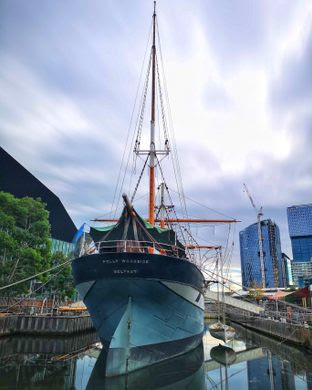
POLLY WOODSIDE
- AUSTRALIA -
G'day folks,
This historic tall ship traveled 1.5 million miles around the globe, and once did duty as the mythical pirate ship in Peter Pan.Launched from the same Belfast shipyards some 25 years before the Titanic, the Polly Woodside was a three-masted, iron-hulled barque designed not for luxury but as a global workhorse, and it ended its days as an ignominious coal lighter in Melbourne.
With only maps, compass, and a sextant to rely on, some ships left on a voyage and were never seen again, though the Polly had an exceptional safety record: Only eight sailors met their end on her watch.
The Polly was little more than a wreck when it was saved and restored by National Trust of Australia volunteers as the last of its kind. The ship was restored to 90 percent accuracy from recreated blueprints, and opened as a living museum in 1978.
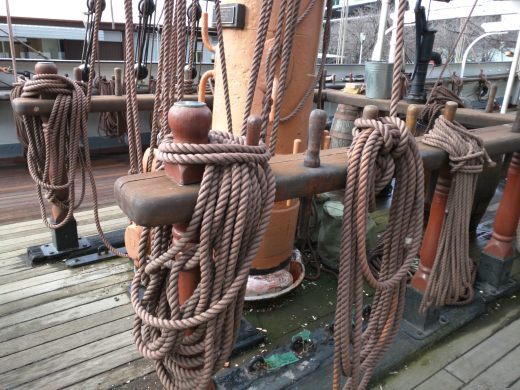
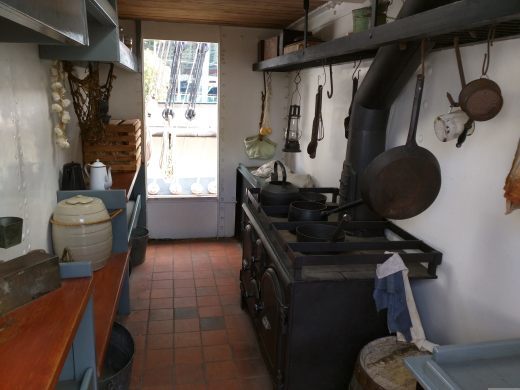
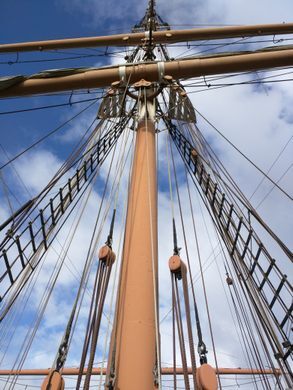



It is docked permanently alongside a small but excellent museum, which has many mementos from crew life onboard including diaries, letters, pictures, flags, sails and tools.
Once onboard you can smell the tar still used to waterproof the deck, and then see how the officers and regular crew lived uncomfortable lives—a separate bathroom being a luxury only the captain was allowed.
If it’s windy day you might hear the thrash of rigging, or below deck, the creaking groan of the wood.
Post-retirement, the Polly had a brush with the big screen when she was temporarily renamed the Jolly Roger when Australian actors Hugh Jackman and Levi Miller did press for Pan, the 2015 family fantasy movie retelling of the classic tale by J. M. Barrie.

Clancy's comment: I visited this ship many years ago and was very impressed.
I'm ...


23 March 2022 - GREAT QUOTES WORTH READING

GREAT QUOTESWORTH READING
G'day folks,
Welcome to some more interesting quotes.

















Clancy's comment: Mm ... Some cool ones here.
I'm ...


February 5, 2022
22 March 2022 - WEBB BRIDGE - MELBOURNE, AUSTRALIA
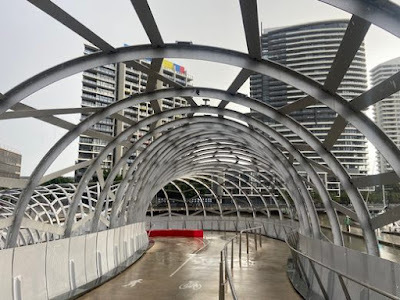
WEBB BRIDGE
- MELBOURNE, AUSTRALIA -
G'day folks,
This modern pedestrian bridge on the Yarra River was modelled after an Aboriginal fish trap.Melbourne has many bridges that cross the Yarra River, ranging from the West Gate Bridge to the many bridges that take pedestrians, motor vehicles, and trains from one side of the city to the other. The Webb Bridge is one of the most eye-catching and striking modern designs. It has won many awards in recognition of its unique composition.

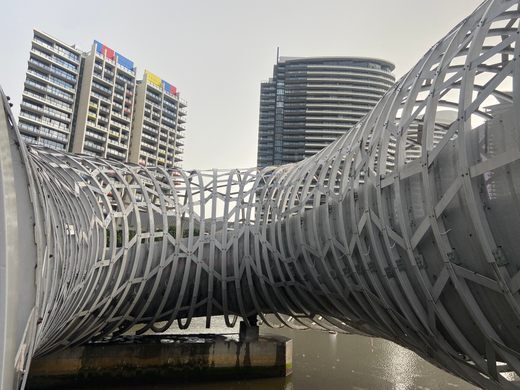
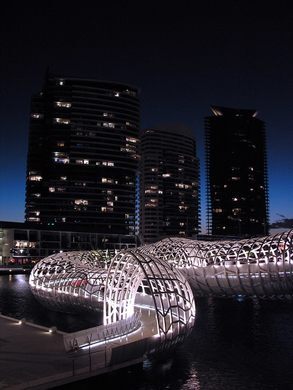
It was designed by Denton Corker Marshall, an international architecture firm, along with famous Australian artist Robert Owen. The shape of the bridge pays tribute to the Aboriginal history of the land and is modeled on a traditional Koorie fishing trap, used to catch eels. This tribute to indigenous history is a well-used structure and provides a connection over the Yarra River between the areas of Docklands and Southbank.
The bridge lights up during the evenings and provides a great viewpoint for the expanding central area of Melbourne City. Visitors can look out towards the mouth of the river and get a sense of tranquility away from the bustling city that lies on the other side.

Clancy's comment: This is the capital of my state. Although modern, this bridge is not as appealing as some of the other older bridges in Melbourne.
I'm ...


6 February 2022 - STALAG LUFT III PRISON CAMP MUSEUM - POLAND
 Stalag Luft III Prison Camp Museum- POLAND -G'day folks, This is the site of one of the largest prison escapes of World War II.
Stalag Luft III Prison Camp Museum- POLAND -G'day folks, This is the site of one of the largest prison escapes of World War II. Though this site in the Polish town of Żagań has a long military history, it is best known for its use as a Luftwaffe-run prisoner-of-war camp during the Second World War. Specifically, for being the site of one of the largest prison breaks of the war, which was made famous by the 1963 film “The Great Escape.”
In 1944, 76 allied prisoners at the Stalag Luft III camp, hailing from a variety of different countries, escaped from under the noses of the Germans through a tunnel they dug by hand. Sadly, nearly all of the escapees were eventually caught; 50 were executed and another 23 were returned to POW camps. Only three of the 76 men managed to escape successfully.






The site of the former POW camp is now a museum, which features a full-size replica of the hut where the men planned their daring mass escape, and displaying many original items from the prison camp. One room in the hut is dedicated to another breakout from the camp, the “wooden horse” escape of 1943. In this plot, a group of POWs vaulted over a wooden horse built near the camp fence line, while two men hidden inside the horse gradually dug their way to freedom over a period of three months.
About a half-mile drive from the hut you can also see the “Harry” tunnel dug by the prisoners (one of three tunnels dug: Tom, Dick, and Harry), which now serves as a memorial. Here you can see exactly how long the tunnel was and the exit and entry points. A guard tower has been reconstructed to show the proximity of the tunnel exit to the attentive German soldiers on patrol. You are also able to wander through the woods and see some of the original foundations of the camp.
A final location, for those interested, is a further half-mile down the road. There is a cemetery here with the original mausoleum built for the 50 men who were executed. Their ashes were later moved to the military cemetery in Poznan.
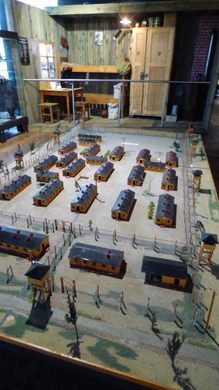
Clancy's comment: I've been to a few prison camps in Europe, but not to this museum.
I'm ...


January 26, 2022
7 February 2022 - NEW RELEASE YOUNG ADULT FANTASY/ADVENTURE NOVEL by Elaine Ouston

NEW RELEASE YOUNG ADULT
FANTASY/ADVENTURE NOVEL
by
Elaine Ouston
G'day folks,
It's been a while since I have promoted another author, but today is the day. Elaine Ouston is a colleague and friend who has assisted me in my career as an author. Not only does she run a publishing and editing business, she also has written a heap of books. This is her latest release.

'RESTORING DESTINY'
What would you do if you were told your mother was to be executed on the next full moon, and you were the only one who could save her? That could be a hard thing to accept.
But that is the fate that is thrust upon the main characters in Elaine Ouston’s new young adult novel. Read more about Elaine and this exciting novel below.
WHO IS ELAINE OUSTON?
Elaine Ouston is a multi-published author, writing tutor and editor. Her books include picture books for young readers, chapter books, and novels for middle grade readers. She has recently added a young adult fantasy novel, Restoring Destiny to that list. Today we are going to learn about the book’s journey to publication.
SOME BACKGROUND ABOUT THE BOOK:
Synopsis: Restoring Destiny: a story of magic, deceit, teen romance, and a fight to save a life and right the wrongs of yesteryear. Rais and Kanda’s frustration at living in a cloistered world ends when the evil ruler’s troops come to capture them. They escape and are thrust into an unknown world, not knowing who to trust or where to go. All they know is they must find a man called Briador and be somewhere by the full moon, 14 suns away, to save a life that only they can save.
WHAT WAS YOUR INSPIRATION FOR THIS NOVEL?
In about 2005 I was in a workshop called The Hero’s Journey presented by Paul Collins. We had to plan a fantasy novel using the prompts he gave us. I set out the bones of this story there. But it sat for some time as other stories and life got in the way of developing it.
WHEN DID YOU FINALLY FINISH IT?
In 2008, when I started my study for a Master of Letters in Creative Writing, I pulled out the plan I had written in Paul’s workshop and developed it as the creative component of that degree. The first 30,000 words of Restoring Destiny were written for this purpose. My degree was completed in 2010. I was thrilled when I obtained a Distinction for the course.
My supervisor was a fantasy reader and remarked that my story was better than some of the published ones he read. On a high from that, I set out to finish the novel, but work and other stories got in the way.
I worked on it between jobs and other books and finished it early 2020. With the usual amount of editing and revising it was finally ready for publishing in December.
I sent it out for reviews and was excited to receive the following two reviews.

Review from Gayle Torrens – author
‘I recently got a copy of this book for my grandson, but I made the mistake of reading the first chapter to see if I thought he’d like it. That was it. The book never left my hands until I finished it.
‘This is a great fantasy story; well-written and saturated with enough excitement to keep the reader enthralled throughout.
‘The characters are beautifully developed, and I was drawn to them immediately. The male character, Rais, is brave, selfless, and ingenious and will appeal to the young male readers. His sister Kanda is loyal, feisty, and indomitable and I’m sure young female readers will quickly bond with her.
‘The plot is exciting and unpredictable and there are just enough teasers offered throughout the novel to keep the reader turning pages.
‘A great YA novel that would make a welcome gift for any young bookworm.’
Review from award winning author, Aleesah Darlison.
‘Impeccable from the first page, Restoring Destiny is a deftly written high fantasy adventure novel. The characters are strong, fierce, and relatable and the story is packed with action and surprises. Get set for a remarkable ride!’

Thanks, Clancy for inviting me to your blog. The book may not have hit the bookshops yet, but it is available from my website.


www.elainejouston.com or the publisher’s website www.morrispublishingaustralia.com and many online stores as a printed book or eBook.

Clancy's comment: Go, Elaine! I hope it's a big success. Don't be shy, folks. Grab a copy.
As always ... love ya work, Elaine!
I'm ...


January 22, 2022
6 March 2022 - REMNANTS OF AN AMUSEMENT PARK

REMNANTS OF AN
AMUSEMENT PARK
G'day folks,
This public space is speckled with the eerie remnants of a defunct amusement park.New Castle, Pennsylvania, was a booming town at the turn of the 19th century, when the local amusement park, Cascade Park, attracted people from around Pennsylvania and Ohio. Officially opened on May 29, 1897, the park had a dancing pavilion (once the largest in the state), an outdoor theater, a rollerskating rink, Caterpillar and Dodg’em rides, a grandstand, and an indoor a rollercoaster called “the Figure Eight.” Folks would ice skate in the winter and swim in the pool in the summer.


Unfortunately, in the summer of 1927, a tragic accident occurred that would mark the beginning of the end for the park. Two guests died that were riding in the first car of the rollercoaster, which dipped through a gorge in the park. Some accounts said the victims were thrown from the car, while others said they were standing up in the car. After the deaths, the park put buckle straps onto the ride to prevent further issues, and the rollercoaster was eventually demolished due to termites.
In 1954 a new rollercoaster was built, taking roughly the same journey as the previous ride. Still, in the decades that followed the park experienced many periods of poor maintenance, resulting in many rides being closed for safety or lack of insurance. Vandalism was rampant during the 1980s, even while the park was still open, including someone stealing 15 carousel horses.
The second rollercoaster met its demise when a falling tree caused damage deemed too expensive to repair in 1982. The ’90s saw the park begin to look more like it does today: a nature park with picnic shelters, a playground, a restored carousel house, and fitness trail. While efforts have been made to repair the swimming pool as recently as 2014, you can still find the pool, closed, and in disrepair.
Today, many different relics of what used to exist at Cascade Park can be found, including supports for the rollercoaster along the creek in the gorge (leading to a very pretty waterfall), the remnants of the dam that created the lake, several buildings, seemingly not in use, and random concrete slabs. Still, the park remains in use today for concerts, events, weddings, or a simple leisurely stroll among the remnants of the abandoned rides.

Clancy's comment: What a shame, eh?
I'm ...


January 21, 2022
26 March 2022 - MILLIONAIRE SAVED KIDS ON THE LUSITANIA

MILLIONAIRE SAVED
KIDS ON THE LUSITANIA
G'day folks,
American multi-millionaire Alfred Vanderbilt died a hero trying to save women and children aboard the liner Lusitania, which was sunk by a German U-boat in 1915.
The ship, owned by the Cunard Line, was built to dominate the highly lucrative transatlantic passenger trade. Launched in 1906, it was completed the following year as the largest ship in the world weighing 31,550 tons.
The maiden voyage of the 787 feet (240 metres)-long liner took place on September 7, 1907, when she sailed from Liverpool in England to New York City. On this day the ship was reversing that voyage and was heading to the UK from New York with 1,959 passengers and crew on board.
But it was the time of the First World War and Germany, with a formidable fleet of submarines – or U-boats – was attempting to stop vital supplies reaching the UK across the Atlantic. Germany had declared the seas around the UK a war zone and warned that Allied ships in the area would be sunk without warning.
Nobody seriously thought this threat would apply to a non-military luxury passenger liner such as the Lusitania, especially as she would be bound to have many neutral Americans on board.
But Germany took a different view and its embassy in the United States had placed a warning in 50 American newspapers, including those in New York, explaining the dangers of sailing to the UK. It read:
Notice!
Travellers intending to embark on the Atlantic voyage are reminded that a state of war exists between Germany and her allies and Great Britain and her allies; that the zone of war includes the waters adjacent to the British Isles; that, in accordance with formal notice given by the Imperial German Government, vessels flying the flag of Great Britain, or any of her allies, are liable to destruction in those waters and that travellers sailing in the war zone on the ships of Great Britain or her allies do so at their own risk.
Imperial German Embassy Washington, D.C., 22 April 1915.
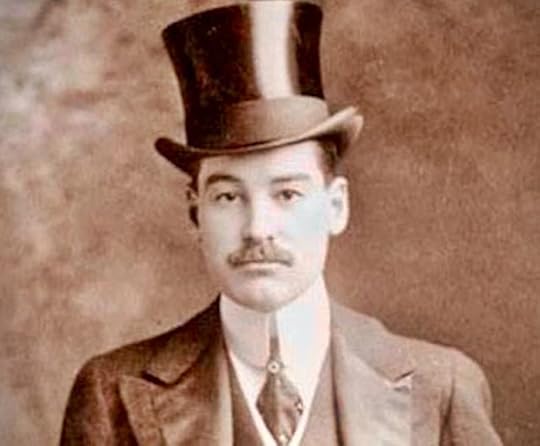
Some New York newspapers had printed the warning directly next to Cunard’s list of departure dates, and as the Lusitania got under way the dock was crowded with reporters. They saw that despite the German threat the ship was packed with passengers.
Clearly they believed that a luxury liner with no obvious military value would not be a target. Two other factors boosted confidence. First, Cunard had declared the Lusitania to be the “fastest and largest steamer now in the Atlantic service”. So, in the highly unlikely event of a threat, it was thought, she could outpace any German vessel and thus escape danger.
Secondly, several rich and famous people such as Alfred Gwynne Vanderbilt and wine merchant George “Champagne King” Kessler had come on board, inspiring confidence. Obviously they would have had access to high-level information warning them if danger really did exist.
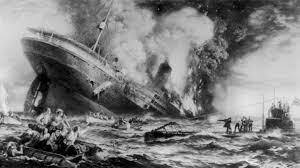
William Turner, the captain of the Lusitania, known as "Bowler Bill" because he usually wore a bowler hat when ashore, received advice from the British Admiralty on how to avoid making his ship an easy target. He was urged to alter course every few minutes at irregular intervals so that the evasive tactic of zigzagging would thwart any attempt by U-boats to plot the Lusitania’s course.
Captain Turner ignored the advice and on the afternoon of May 7, just off a headland near Kinsale, County Cork, Ireland, a torpedo fired by a German U-boat exploded amidships on the Lusitania’s starboard side. It was followed by a second explosion, possibly caused by damage to the ship’s steam engines.
Eighteen minutes later, the Lusitania had disappeared beneath the waves and 1,198 people, including 128 American citizens, were drowned. Of the 1,959 passengers and crew only 761 survived.
The victims included Alfred Vanderbilt who, during those 18 minutes, had performed extraordinary acts of courage. He could not swim but made no attempt to push through the crowd and get into a lifeboat.
Instead, he and his valet calmly helped several women and children to safety. According to reports a steward saw Vanderbilt “vainly attempting to rescue a hysterical woman” and shouted to him: “Hurry Mr. Vanderbilt, or it will be too late!” Vanderbilt did not listen and continued to help women and children.
A report in the New York Times four days later told of how a woman passenger overheard the tycoon say to his valet: “Find all the kiddies you can.” According to the report the man rushed off collecting children and as he brought them to Vanderbilt “the millionaire dashed to the boats with two little ones in his arms at a time.”
The report added that “when he could find no more children he went to the assistance of the women and placed as many as he could safely in the boats. He continued his efforts until the very end.”
Vanderbilt was last seen helping a nurse put on a lifebelt, but before he could finish securing it they were both washed off the deck. The body of the 37-year-old millionaire was never found.
President Woodrow Wilson had announced at the start of the war that the United States would remain neutral and he was supported by a majority of the American people.
But the sinking of the liner and the loss of so many passengers, including those 128 Americans, caused a wave of indignation across the United States and it was expected that a declaration of war would follow. The Government, however, clung to its policy of neutrality and its reaction to the sinking simply amounted to three separate notes being sent to Berlin condemning the German submarine war policy.
To placate America, the Germans gave an informal assurance to President Wilson that there would be no repeat of the Lusitania incident and they would end their “sink on sight” policy. They did so on September 18, 1915.
It was, however, re-introduced on February 1, 1917 and by April of that year, five American merchant ships had been sunk, causing the United States to declare war. The sinking of the Lusitania became an iconic symbol in military recruiting campaigns.
Alfred Vanderbilt’s grandson grew up on stories of his grandfather’s gallantry. As a 65-year-old public relations executive, Alfred Vanderbilt III told the Irish Times in April, 2021: “He spent his last minutes trying to save the children on the Lusitania. I can’t think of anybody braver. How do you do that?”
Answering his own question, the grandson added: “He had been brought up to do the right thing. He saw his moment and he took it. What I have heard from my family over and over again is what a wonderful man he was. It is not as if he was a bad guy who got a good reputation because of his death. He was really a loving and caring man.”
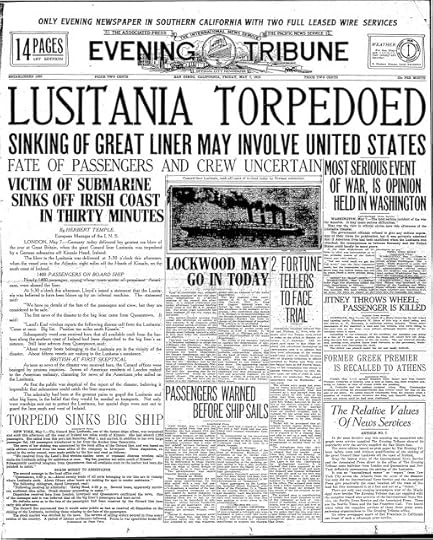
Clancy's comment: Very interesting. I bet many would not be so heroic.
I'm ...


January 19, 2022
25 March 2022 - WHAT HAPPENED TO ADOLF HITLER'S BODY?
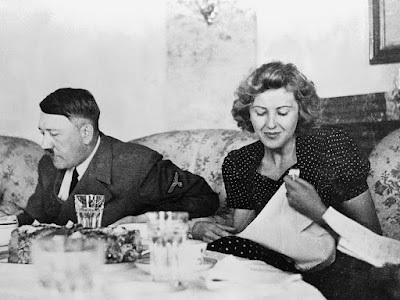
WHAT HAPPENED TO
ADOLF HITLER'S BODY?
G'day folks,
He boasted that his Third Reich would last for a thousand years. But Adolf Hitler, who would go down in history as an evil tyrant, shot himself on this day, probably after taking poison, painfully aware of the disintegration of his twelve-year-old regime and with his capital city reduced to ruins and rubble.
As the Second World War was coming to a close the desperate Führer tried to wage war by telephone from his bunker beneath his headquarters, the Chancellery building in Berlin, issuing futile orders to his defeated generals.
The 3,000-square-foot underground bunker, completed in 1942, was basically an extension of the Chancellery’s air raid shelter. It consisted of two levels and 18 rooms. However, Hitler had his favourite architect, Albert Speer, build an additional bunker under the Chancellery’s garden.
It was finished in October 1944 and was known as the Führerbunker. And it was here, alongside his wife of a few hours, that Hitler ended his life.
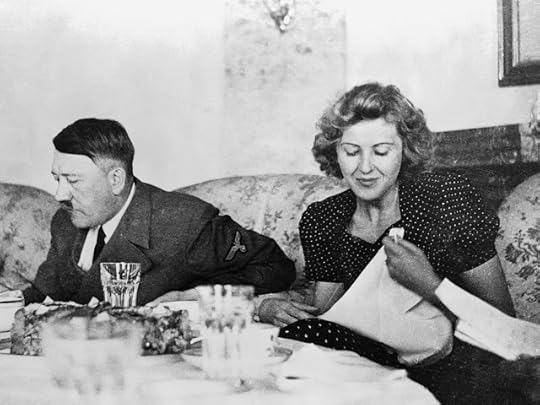
For three months military advisers had been urging the Führer to abandon the bunker and flee to his Eagle’s Nest retreat high above the Bavarian Alps at Berchtesgaden. But he refused to leave his underground lair, remaining there for about 100 days.
It is believed he feared the possibility of capture and being put on display – dead or alive – by his enemies, especially the Russians.
Just a few days before Hitler’s 56th and final birthday on April 20, the Russians arrived at the edge of Berlin. By April 24, they had the city completely surrounded as the Americans and the British moved closer.
By April 29, knowing all was lost, Hitler was preparing for death, taking with him his 33-year-old companion Eva Braun who had flown from Munich to Berlin earlier that month to be with the man she worshipped.
They had been together since 1932 when Braun, an attractive young photography assistant at the time, came under Hitler’s spell. Urged by Hitler to leave the bunker for her own safety, she refused, allegedly saying: “Do you think I will let you die alone?”
Despite her dedication, her chances even now of Hitler yielding completely to her charms seemed unlikely if his earlier words were to be believed.
Author Gitta Sereny tells in her book 'Albert Speer: His Battle With Truth' how the architect was dining one night with Hitler, Eva Braun at his side. The Nazi leader said that a highly intelligent man should always choose a primitive and stupid woman:
"Imagine if on top of everything else I had a woman who interfered with my work! In my leisure time I want to have peace. I could never marry."
Nevertheless, shortly after midnight on April 29, 1945, Hitler did marry Eva Braun, a minor official from the Propaganda Ministry having been summoned to conduct the ceremony in the bunker.
A few hours later Hitler dictated his last will and a Political Testament. The statement laid all blame for the war on "international Jewry" and urged all Germans to continue fighting.
The will, dated 4am, 29th April, 1945, declared: "As I did not consider that I could take responsibility, during the years of struggle, of contracting a marriage, I have now decided, before the closing of my earthly career, to take as my wife that girl who, after many years of faithful friendship, entered, of her own free will, the practically besieged town in order to share her destiny with me.
"I myself and my wife - in order to escape the disgrace of deposition or capitulation - choose death. It is our wish to be burnt immediately on the spot where I have carried out the greatest part of my daily work in the course of a twelve years' service to my people."
The next day, 30th April, with the Russians less than a city block away, Hitler and Braun ate their final meal. Shortly after 3pm, they said goodbye to the staff in the bunker and retired to their private chambers, taking with them revolvers and thin glass vials of cyanide.
There was a loud gunshot at about 3.30. After waiting a few minutes, Hitler’s valet, Heinz Linge, opened the door and saw the Führer almost upright in a sitting position on a blood-soaked sofa.
It was assumed that Hitler had made certain of death by using his pistol on himself after biting the cyanide vial. Blood had trickled from a small hole in his right temple. The pistol lay on the floor where it had dropped from his right hand.
Eva Braun lay beside him, but she had made no use of the revolver at her side, preferring to take the poison instead.
Later, Radio Hamburg announced that "our Führer Adolf Hitler died for Germany in his command post in the Reich Chancellery this afternoon, fighting to his last breath against Bolshevism".

The bodies of Hitler and Braun were wrapped in blankets and carried to the Chancellery garden. There, one of the Führer's personal assistants, SS Officer Otto Günsche, doused the bodies in petrol and burned them, in accordance with Hitler’s final orders.
What happened to the charred remains is still uncertain. Hitler's men buried them in a nearby shallow bomb crater where apparently they were discovered by the Russians. The remains were then transported to the city of Magdeburg, south-west of Berlin, after being buried and exhumed several times by Russian soldiers.
Finally, the story goes, they were buried in the courtyard of the Russian counter-intelligence agency's facility in Magdeburg and remained there for 25 years.
When control of the city was handed to East Germany in 1970, the KGB exhumed and fully cremated the remains fearing that Hitler's burial site could become a place of worship for supporters of fascist ideas. The ashes were then scattered in the River Elbe. So it is said. But nobody knows for sure.
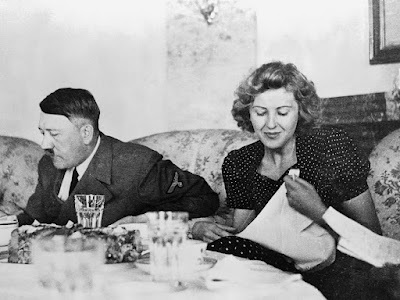
Clancy's comment: Have we learnt anything from all this? I don't think so.
I'm ...


3 March 2022 - W.R. HEARST - MASTER OF FAKE NEWS
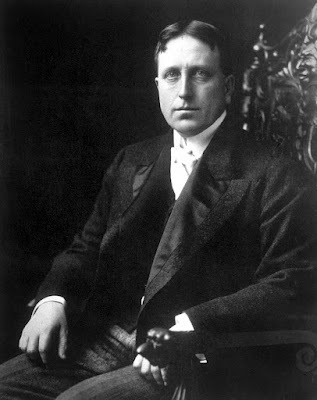
W.R. HEARST
- MASTER OF FAKE NEWS -
G'day folks,
“Fake news” has its roots, many people believe, in the birth of William Randolph Hearst on April 29th 1863. Hearst was given the San Francisco Examiner by his father, George, a miner who had become a multi-millionaire and US Senator.
Relishing his role as an influential editor, the young Hearst later moved to New York City and acquired the New York Journal. As he fought a bitter circulation war with Joseph Pulitzer's New York World, the age of yellow journalism was born.
This was later defined by American historian and journalist Frank Luther Mott as a type of journalism that presents little or no legitimate well-researched news and instead uses eye-catching headlines and sensationalised stories to sell more newspapers. It sometimes also deceives the audience it is intended for, he said.
Yellow journalism, Mott added, “is defined by five major characteristics”:
1) Scare headlines in huge print, often of minor news.
2) Lavish use of pictures, or imaginary drawings.
3) Use of faked interviews, misleading headlines, pseudo-science, and a parade of false learning from so-called experts.
4) Emphasis on full-colour Sunday supplements, usually with comic strips.
5) Dramatic sympathy with the "underdog" against the system.
This all squares with Hearst’s view that an ideal newspaper is one that causes the following reaction:
"When the reader looks at Page One, he says, 'Gee-whiz.' When he turns to the second page, he says, 'Holy Moses.' And when he turns to the middle page, he says, 'God Almighty.'
Hearst went on to build a chain of nearly 30 newspapers across America, then expanded into magazines, creating the largest newspaper and magazine business in the world.
He did so by sticking rigidly to circulation-building sensationalism. And what could be more sensational and reader-appetising than a war? So when the Cuban struggle for independence from Spain began in February 1895, Spain’s use of brutal suppression was graphically – and imaginatively – portrayed by Hearst’s newspapers.
He backed the underdog Cubans fighting on America’s doorstep and agitated for the United States to declare war on Spain.
In 1897 he sent artist Frederic Remington to Havana with instructions to illustrate the tension. After some time the artist sent a note to Hearst saying: “Everything is quiet. There is no trouble. There will be no war. I wish to return.”
Hearst replied: “Please remain. You furnish the pictures and I’ll furnish the war.”
There is some dispute whether this exchange ever took place, but it is ingrained in the Hearst legend and seems to be well in accord with his thinking at the time.
In 1919 Heart’s mother Phoebe died and he inherited the family fortune, considerably boosting his already substantial personal wealth.
Part of his inheritance was a 168,000-acre ranch at San Simeon, California. For several decades he was to spend millions of dollars on the property, creating a Baroque-style castle and filling it with hugely valuable treasures and works of art which he collected on his global travels. Now called Hearst Castle, it is run by the State of California as a museum and tourist attraction.

Known to his employees as “The Chief”, Hearst delivered some memorable observations about newspapers. Such as:
“News is what people don't want you to print. Everything thing else is advertising.”
“Putting out a newspaper without promotion is like winking at a girl in the dark – well-intentioned, but ineffective.”
One girl he certainly winked at effectively was Marion Davies, a Hollywood actress whose career he managed and whose films he promoted through his newspapers. He had met her in 1917 when she was a showgirl and she became his mistress for many years.
Such was his devotion that when in 1925 he saw pictures in a magazine of the historic and romantic St Donat’s Castle in South Wales he bought it for her. Then he spent a fortune renovating it.
Few mistresses can have received such a lavish gift. The playwright George Bernard Shaw said of the castle: "This is what God would have built if he had had the money.”
In 1941, young film director Orson Welles brought out Citizen Kane, a biography in all but name of the newspaper mogul. It was nominated for nine Oscars and has since been voted one of the world’s greatest films. But Hearst hated it and used his money and influence in unsuccessful attempts to prevent the film’s release.
In 1947, afflicted by declining health, Hearst went to live in Beverly Hills at a mansion now known as Beverly House (where, incidentally, JFK and Jackie Kennedy were to spend their honeymoon). Hearst died there in 1951, aged 88.

Clancy's comment: He sounds like our Rupert Murdoch. Funny about that, eh?
I'm ...


January 17, 2022
5 March 2022 - ABANDONED ADRIA PALACE - HUNGARY

ABANDONED ADRIA PALACE
- HUNGARY -
G'day folks,
This building has survived for more than a century and remains virtually untouched.Liberty Square is one of Budapest’s most well-known places. However, most visitors to the area ignore a massive hidden gem in the neighborhood. Actually, it’s not hidden, as it happens to be a large tenement house that can be seen from Liberty Square. This is Adria’s Palace.

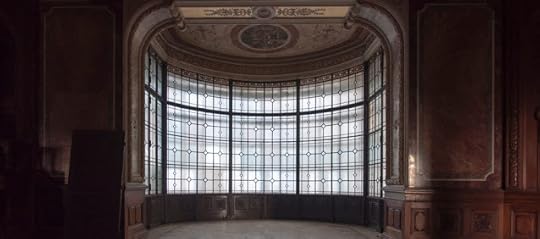

Completed in 1918. the building was once home to the Adriatic Insurance Company. The palace is abandoned but doesn’t resemble your typical forlorn building filled with dilapidated fixtures and decay. Visitors won’t find broken walls or graffiti, as it remains the same as it did during its heyday.
The inside of the building is designed with marble walls, stairs with columns, and an amazing courtyard that has been virtually untouched. The gate is permanently open and anyone can visit inside.
The building garnered its name from the days of the Austro-Hungarian empire, when it once bordered the Adriatic. Adria is abandoned, but that hasn’t stopped the location from making several appearances on the big screen.
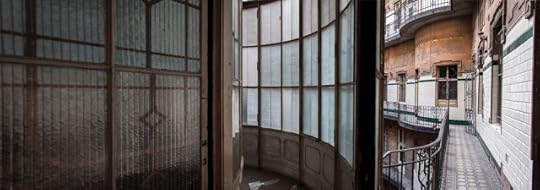
Clancy's comment: What an amazing building, but sad that it's abandoned.
I'm ...





